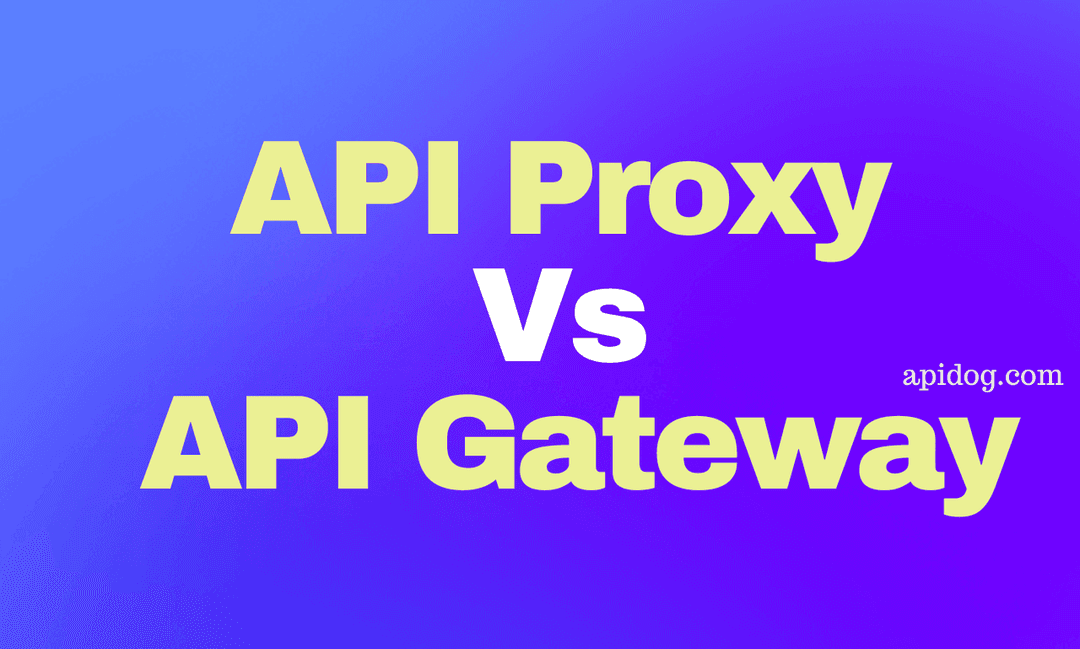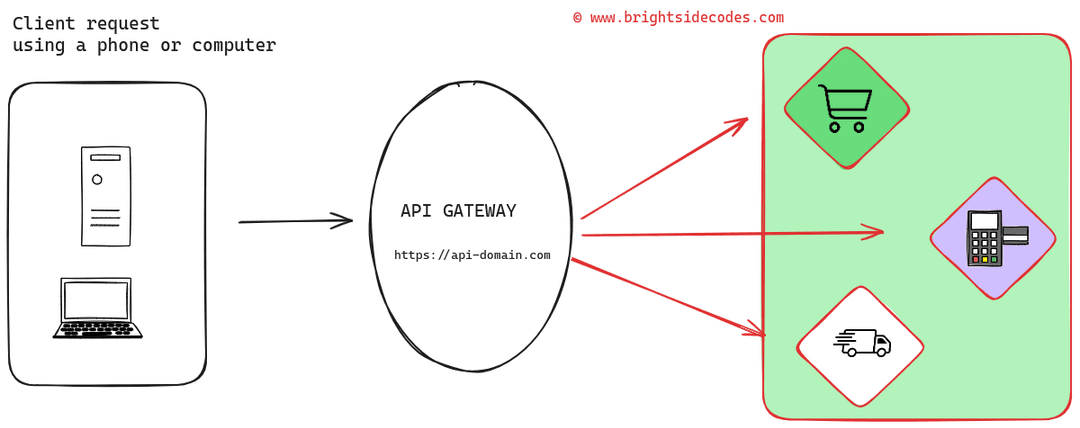
This article was originally written and posted on Apidog.
As APIs grow in importance, managing them effectively becomes critical. This is where API proxies and API gateways come into play. Both serve as intermediaries that facilitate API management, but they have distinct roles and functionalities. Understanding the differences between an API proxy and an API gateway is vital for choosing the right tool to meet specific API management needs. This article explores these differences, helping you make an informed decision.
Now, let's dive in and explore what API gateway and API gateway involve.
What is an API Proxy?
An API proxy is a server that acts as an intermediary between a client application and a backend service. It functions by receiving API requests from the client, forwarding them to the appropriate backend server, and then returning the server’s response to the client. This intermediary layer provides a means to manage and modify API traffic without altering the backend service itself.
Basic Functionality and How It Works:
API proxies primarily offer three core functionalities:
Request Forwarding: The fundamental role of an API proxy is to forward requests from the client to the backend service and then return the responses back to the client. By doing so, the proxy abstracts the backend service details from the client, effectively decoupling the client from direct interaction with the backend.
URL Mapping: API proxies can map client-facing URLs to different backend service URLs. This feature allows for flexibility in backend service changes without impacting the client-side configuration. For example, if the backend service URL changes, the proxy can simply update its mapping, and the client continues to use the same URL.
Basic Security Features: API proxies provide essential security measures such as IP whitelisting, which restricts access to certain IP addresses, and rate limiting, which controls the number of requests a client can make in a given time period. Basic authentication mechanisms can also be implemented to ensure only authorized clients can access the backend services.
Use Cases and Scenarios
Now that we've seen some of the benefits of an API proxy, it's also good to know some of the use cases of API proxy. API proxies are particularly useful in several scenarios:
Security Enhancement for Legacy APIs: For older APIs that lack built-in security features, an API proxy can add a layer of protection without modifying the existing codebase. This ensures that sensitive data and services are better protected from potential threats.
Simple Transformations: When minor modifications to the request or response are needed, such as changing HTTP headers or modifying URL paths, an API proxy can perform these transformations on-the-fly without the need to alter the backend service.
Traffic Redirection: During a backend migration or version upgrade, an API proxy can redirect traffic from old API endpoints to new ones seamlessly. This ensures continuity of service for the clients without requiring them to update their configurations.
Advantages and Limitations
Advantages of API Proxy:
One of the primary advantages of an API proxy is its ease of implementation. Setting up an API proxy is straightforward and does not require significant changes to existing systems. This simplicity makes it ideal for quickly deploying solutions that add security and manage traffic without a steep learning curve or extensive development effort. Additionally, API proxies enable rapid deployment of security and traffic management features, providing immediate protection and control over API traffic. This quick turnaround is beneficial for organizations that need to enhance their API security and management capabilities on short notice.
Another key advantage is the low performance overhead. Since API proxies are designed to perform relatively simple tasks, they introduce minimal latency and ensure that the user experience remains smooth and unaffected. This efficiency is crucial for applications where performance is a critical factor. By handling basic transformations and forwarding requests efficiently, API proxies help maintain high levels of responsiveness and reliability in API interactions.
Limitations of API Proxy
Despite their benefits, API proxies come with limitations, primarily due to their basic functionality. While they are suitable for straightforward use cases, they lack the advanced features found in more comprehensive solutions like API gateways. For example, API proxies do not support complex request and response manipulations, detailed analytics, or sophisticated routing mechanisms. This limitation makes them less ideal for applications requiring extensive customization and fine-grained control over API traffic.
Scalability is another concern with API proxies. While they perform well for small to medium-scale applications, they may struggle to handle the demands of large-scale, highly dynamic environments. API gateways address some of these issues and we'll learn about API gateways soon!
In conclusion, API proxies serve as a valuable tool for basic API management needs, providing a simple and effective way to secure and manage API traffic. They are particularly useful for adding security to legacy systems, performing minor transformations, and redirecting traffic during migrations. However, their limited functionality and scalability suggest that they are best suited for simpler, less demanding scenarios.
What is an API Gateway?

An API gateway is a server that acts as a single entry point for multiple APIs, providing a comprehensive solution for managing API traffic between clients and backend services. It is designed to handle a wide range of tasks, including request routing, load balancing, rate limiting, authentication and authorization, data transformation, and monitoring. By consolidating these functionalities into a single layer, an API gateway simplifies the management and security of APIs, especially in complex environments.
Here's an article that explains what Microservices is.
Comprehensive Functionality and How It Works
API gateways offer extensive capabilities that go beyond simple request forwarding:
Request Routing: API gateways direct incoming API requests to the appropriate backend services based on the request path, headers, or other criteria. This ensures that each request reaches the correct destination efficiently.
Load Balancing: To manage traffic and ensure high availability, API gateways distribute incoming requests across multiple instances of a backend service. This helps prevent any single instance from becoming a bottleneck and improves the system's overall reliability.
Rate Limiting: By controlling the number of requests a client can make in a given time period, API gateways protect backend services from being overwhelmed by excessive traffic. This feature is crucial for maintaining service quality and preventing abuse.
Authentication and Authorization: API gateways enforce security policies by validating the identity of clients and ensuring they have the necessary permissions to access specific resources. This includes integrating with identity providers and implementing OAuth, JWT, and other authentication mechanisms.
Data Transformation: API gateways can modify requests and responses on-the-fly, transforming data formats, adding or removing headers, and even aggregating data from multiple services. This flexibility allows for seamless communication between clients and services that use different protocols or data formats.
Monitoring and Analytics: By providing detailed metrics and logs, API gateways offer insights into API usage, performance, and error rates. This information is invaluable for troubleshooting issues, optimizing performance, and understanding how APIs are being used.
Use Cases and Scenarios
API gateways are essential in scenarios that require robust and scalable API management:
Microservices Architecture: In a microservices environment, where multiple services need to communicate efficiently, an API gateway serves as the central hub that manages interactions and ensures secure, reliable communication between services.
Complex API Ecosystems: For applications with a large number of APIs and diverse clients, an API gateway simplifies the management of traffic, security, and transformations, providing a unified interface and reducing complexity.
Advantages and Limitations
Advantages:
API gateways offer a high degree of flexibility and customization, making them suitable for complex and large-scale applications. They provide advanced features such as sophisticated routing, detailed monitoring, and robust security mechanisms, which are essential for managing modern API ecosystems. By consolidating multiple functionalities into a single layer, API gateways reduce the burden on backend services and improve overall system efficiency.
Another significant advantage is their scalability. API gateways are designed to handle large volumes of traffic and can be scaled horizontally to meet the demands of growing applications. This scalability ensures that services remain responsive and reliable, even as the number of clients and the volume of requests increase.
Limitations:
Despite their extensive capabilities, API gateways can introduce additional complexity and overhead. Implementing and managing an API gateway requires a higher level of expertise and can involve a steep learning curve. This complexity can lead to increased operational costs and the need for specialized skills.
Performance overhead is another consideration. While API gateways provide numerous benefits, the additional processing required for tasks such as authentication, rate limiting, and data transformation can introduce latency. It is crucial to optimize the configuration and ensure that the gateway's performance impact is minimized.
In summary, API gateways are powerful tools for managing complex API environments, offering a wide range of features that enhance security, performance, and scalability. They are particularly well-suited for microservices architectures and large-scale applications where advanced API management is essential. However, their implementation requires careful planning and expertise to balance the benefits against the potential complexities and performance considerations.
Now that we've gotten an overview and clear explanation of what API Proxies and API gateway are, it's a good idea to see the main differences between API Proxies and API gateways.
Key Differences Between API Proxy and API Gateway
Scope of Functionality:
API Proxy: Offers basic functions like request forwarding, URL mapping, and simple security features.
API Gateway: Provides comprehensive management, including advanced routing, load balancing, rate limiting, authentication, data transformation, and detailed monitoring.
Performance and Scalability:
API Proxy: Introduces minimal performance overhead, suitable for simpler, smaller-scale applications.
API Gateway: Handles complex tasks and scales horizontally, ideal for large, dynamic environments.
Security Features:
API Proxy: Provides basic security measures such as IP whitelisting and basic authentication.
API Gateway: Enforces robust security policies, including advanced authentication and authorization mechanisms.
Management and Monitoring:
API Proxy: Limited to basic monitoring capabilities.
API Gateway: Offers detailed analytics and logging for better insights and troubleshooting.
Choosing Between an API Proxy and an API Gateway
When deciding between an API proxy and an API gateway, consider the following factors:
Application Scale and Complexity:
API Proxy: Best for small to medium applications with straightforward API management needs.
API Gateway: Suitable for complex, large-scale applications, especially those using microservices.
Security Requirements:
API Proxy: Adequate for basic security enhancements.
API Gateway: Necessary for applications requiring advanced security and compliance.
Performance Considerations:
API Proxy: Ideal when low overhead and simplicity are priorities.
API Gateway: Preferred for scenarios needing comprehensive features despite potential performance trade-offs.
Cost Implications:
API Proxy: Generally more cost-effective for simpler use cases.
API Gateway: Investment in a gateway is justified for applications that demand extensive functionality and scalability.
You can select the appropriate tool to meet your API management requirements by carefully evaluating these factors. Additionally, leveraging tools like Apidog can further streamline the process of designing, testing, and managing APIs, complementing the use of both API proxies and gateways.
Conclusion
Understanding the differences between an API proxy and an API gateway is crucial for effective API management. While API proxies offer simplicity and quick deployment for basic API traffic management, API gateways provide comprehensive solutions for complex, large-scale environments. Choosing the right tool depends on your application's scale, security needs, and performance requirements. By carefully evaluating these factors, you can ensure that your API management strategy aligns with your business objectives and technical demands.